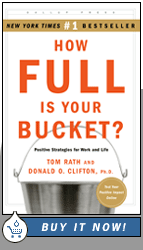|
|
RatHowf
06-12-176 HOW FULL
IS YOUR BUCKET? Positive
Strategies for Work and Life Tom Rath and Donald O. Clifton |
|
Tom Rath is the grandson of Don Clifton, coauthor of Now, Discover Your Strengths and the Clifton StrengthsFinder assessment. Rath is a Global Practice Leader at The Gallup Organization. Have you ever spent hours on the phone trying to help a service representative solve your problem? Have any of them been so friendly and helpful that you didn’t resent it? This is one of those little one-hour books that inspires you be like that person, to develop a knack for making people feel good. “How Full is Your Bucket? reveals how even the briefest interactions affect your relationships, productivity, health, and longevity.” (flyleaf) Our lives are shaped by our interactions with others. “The results of our encounters are rarely neutral; they are almost always positive or negative.” “…they accumulate and profoundly affect our lives.” (Introduction) “Negativity Kills.” (17) Theme of the book: “Everyone has an invisible bucket. We are at our best when our buckets are overflowing – and at our worst when they are empty. “Everyone also has an invisible dipper. In each interaction, we can use our dipper either to fill or to dip from others’ buckets. “Whenever we choose to fill others’ buckets, we in turn fill our own.” (25) “Recognition” and “praise” are two critical components for creating positive emotions in organizations.” (27) One manager tries to energize his people in the various offices where he travels. Before arriving he recalls successes and achievements he has heard over the past few months involving people in that office. As he casually visits with these individuals he congratulates them. “His favorite line is: ‘I’ve been hearing a lot of good talk behind your back.’” (29) “The #1 reason people leave their jobs: They don’t feel appreciated.” (30) “It is possible for just one or two people to poison an entire workplace.” “Negative employees can tear through a workplace like a hurricane racing through a coastal town.” (37) “And negative employees scare off customers.” (37) “Praise is rare in most workplaces.” (39) “…positive emotions are an essential daily requirement for survival.” (53) Marriages are significantly more likely to succeed when the couple’s interactions are near a 5 to 1 ratio of positive to negative comments. (research by John Gottman) (55) Optimism early in life predicts good health later in life. (61) “Recognition is most appreciated and effective when it is individualized, specific, and deserved.” (80) Bucket filling builds sustainable relationships and changes people’s lives forever.” (84) Make a habit of filling buckets. (85) Catch yourself in the act of bucket dipping – then stop it. (87) Focus on what is right. Draw attention to things others do well. (91) “Great relationships lead to a significant increase in life satisfaction.” “The happiest people have high-quality social relationships.” “Start by learning the names of people you see regularly – and…make sure you learn the name he or she prefers to be called. …it can make a major impression.” (96) Fill a person’s bucket in your very first interaction. “Begin with the most important people in your life. Tell them how important they are to you and why.” (97) “Listen to your friends with unconditional, positive regard. Support their endeavors. Encourage them.” “At work, become the person known for noticing when others do a great job.” “Create positive interactions with acquaintances – even strangers.” (97) “Look for opportunities to give small gifts to others out of the blue…. Even a smile…” (100) Reverse the golden rule: “Do unto others as they would have you do unto them.” (103) “What we recognize in others helps them shape their identity and their future accomplishments.” (104) Inside the book is a code for using the Clifton StrengthsFinder assessment for free. You can then receive a guide to help build on your top 5 themes of talent. Web site: www.bucketbook.com |
|
* * * * *
